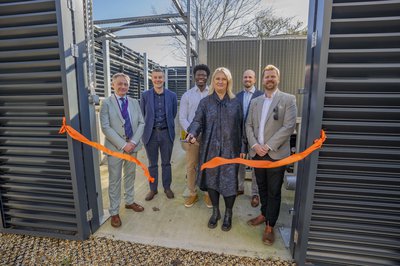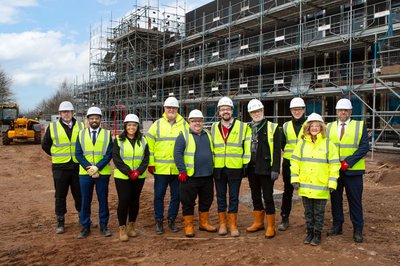St Mark's Church of England School
St Mark's Church of England (CofE) School completed in the winter of 2022 and is Southampton’s first 4-16 all through school. The new building encompasses a pre-school nursery, a two-form entry primary school, a secondary school and sixth-form. Whilst the new facility provides children of the local community a one stop educational hub to learn and develop, it also supports Southampton City Councils wider agenda to address the growing requirement for school places in the area.
Key Stats
- The first all-through school built in Southampton
- 8 work experience placements
- 82% project spend on SMEs
- 44 CCS Score
- 1,513 Volunteer Hours
At a Glance
Budget
£35.2m
Completion
December 2022
Location
Central & West (South)
Framework
PAGABO Framework
Sector
Education, All through school
Social value
£30.2million
Sustainability
97% Waste Diverted from Landfill
Our approach
Due to the need to increase school places in the community, the previous school was demolished and now provides an additional 900 school places taking the total capacity of the building to 1,500 school places.
As the previous school was demolished, the team needed to ensure the students at the existing school had a facility to continue their learning in in the interim. A temporary modular building was constructed and completed in December 2021.
Delivered through the Pagabo framework, the overall works included implementing a new sports building which is located centrally within the site and serves all age groups. Although the design of the building has separate wings for primary and secondary teaching spaces, they are all linked together to enable the campus to operate as one. Other features of the new school include air-conditioned classrooms, an external science courtyard for outside experiments and both natural and artificial grass sports pitches.

History of the school and Archaeological Investigation
Millbrook Central Board School, as it was formerly named, was constructed in 1894 and opened in 1895. Initially boys, girls and infants were taught at the school however, in 1909 the school was separated by sex and age; meaning the boys’ girls’ and infants were split and had separate entrances. The school had then gradually become a secondary and middle school before being renamed as the current St Mark’s CE Primary School in 1988.
The archaeological investigations were likely to spring interesting findings due to being built in the late 1800s. The team found evidence dating back to the late Iron Age–early Romano British period (around 200BC to AD200), which suggests that there may have been a settlement on the site. Overall, 30kg of finds had been discovered alongside postholes and ditches, including fragments of large pottery vessels, possibly used for storage or cooking.
Some of the interesting findings on this project which had all been preserved included: a 19th century Blackwood & Co ink bottle, a Pepsi Cola bottle from the 1930s, a G. Foster Clark & Co. Eiffel Tower Fruit Juices bottle from 1891-1901, bronze, iron age pottery, World War II signs and old hooks which kept barrage balloons in the ground.
Reuse of materials
The previous building was constructed at a time of intense industrialisation and although it was not listed, there was considerable local historic interest in the building. Despite being a new build school, the design team made it imperative that the school acknowledge and maintained the site's Victorian history. The project team used salvaged materials from the demolished school and throughout the building made contemporary references to the existing building such as the inclusion of stone framed windows and string courses.
Saving 4 weeks of first fix activity
Over the project, the team applied over 500 Unistrut Hangers within the concrete soffits. Unistrut is a metal framing system which has a weldless connection. The key to efficiently implementing this was through early engagement with our supply chain and design planning sessions.
Traditionally, we would use four fixings per bracket which would be percussively drilled into the soffit from a podium. Each fixing takes approximately two minutes to drill, subject to rebar, and involves working at height and manual handling. The exposure to Hand Arm Vibration for a drill of this type is generally 15-20 minutes per day for a single operative. Therefore, fixing all of these would be more than 66 hours of constant drilling, or 266 days of operative exposure. Using the Unistrut, meant it was pre-fixed to the deck, providing a completely flat slab. The benefits of this included reduction in operatives’ exposure to noise, vibration, work at height and saving over four weeks of programmed first fix activity.
Social Value
With over 951 hours dedicated to supporting communities, the project team supported several local initiatives. This included spending a day helping Bitterne CE Primary School in Southampton update their outside facilities. We collaborated with our subcontractors on the project and the team spent the day focusing on these key areas for the school as part of our Give and Gain Day. The Give and Gain Day is where we endeavour to give back to the local community. The team upgraded the rotting fence posts and shelter roofs, painted fences and seating areas and removed harmful plants. Our team from MTEC also went back the following week to complete another re-roof of the other children's outdoor area. The team had the support and donated materials from Travis Perkins, Johnstones Decorating Centre, MTEC and Faithful Gould.
The project team sponsored the local football academy Pace Youth Football Club which included donating brand-new football kits to the under 7s Pace Panther team.
The South business also agreed a new five-year partnership with Redbridge community school in Southampton. The five-year partnership will support pupils with their learning, personal and academic development. It also creates training opportunities within its own business.
As a council we are committed to investing in our young people, giving them the best start in life with a high-quality education. So, it’s fantastic to have delivered on our promise to create Southampton’s first state-of-the-art all-through school, creating 900 much needed additional new spaces, so that we can ensure we keep up with growing demand with the increase in pupil numbers from our primary schools - Councillor Satvir Kaur, Leader of Southampton City Council
Gallery
Related News
NEWS

Morgan Sindall Construction and Arts University Bournemouth celebrates completion of decarbonisation project
On Thursday 20 March, Morgan Sindall Construction and Arts University Bournemouth (AUB) celebrated the completion of a decarbonisation project which saw the installation of Air Source Heat Pumps (ASHPs) …
NEWS

Morgan Sindall Construction leads next phase of Southampton City Art Gallery’s historic renewal
Morgan Sindall Construction has commenced the next phase of a £4.3m restoration project at the Grade II* listed Southampton City Art Gallery, marking a significant milestone in the preservation …
NEWS

Morgan Sindall celebrates structural milestone at Nottinghamshire SEN school
Morgan Sindall Construction has marked a major milestone in the delivery of Horizons Academy, a new state-of-the-art, specialist educational needs (SEN) school in Mansfield, with a structure signing event.













